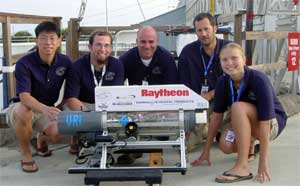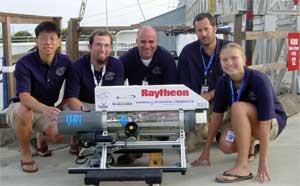 URI engineering students place 4th in international underwater vehicle competition
URI engineering students place 4th in international underwater vehicle competitionTeam brings home $3,000 prize
KINGSTON, R.I. – September 8, 2006 – A team of five engineering students at the University of Rhode Island and their advisor won $3,000 for placing fourth in the ninth annual International Autonomous Underwater Vehicle Competition sponsored by the U.S. Office of Naval Research and the Association for Unmanned Vehicle Systems International.
The students competed against 17 other teams Aug. 2-6 at the Space and Naval Warfare Systems Center in San Diego. The University of Florida placed first, Duke University second and the Ecole de Technologie Superieure in Canada placed third. URI won the competition in 2000, the first year it entered.
The event challenges student engineers to build a miniature robotic submarine that can self-navigate and independently perform realistic missions. This year’s mission involved finding the underwater starting gate, following a pipeline to a specific location, surfacing and then submerging at an acoustic beacon, and homing in on a docking station. Once launched, the vehicles had to complete the mission without any external guidance or control.
“One of our biggest challenges was that we started from scratch this year, rather than just adapting the vehicle our team used last year, which is what all the teams that beat us did,” said Erik Kelly, a senior ocean engineering major from Narragansett and co-captain of the URI team. Other team members were co-captain Alison Laferriere of Exeter (the only team member with any experience in the competition), Alex Sanguinetti of Stamford, Conn., Darren Flynn of Providence, and Huikwan Kim of South Korea. Team advisors are URI Professors Robert Tyce and James Miller.
The URI vehicle is a three-foot long tube that sits on a triangular base and includes two cameras, an acoustic homing system, six microcomputers, and four thrusters with robot combat controllers for propulsion.
“It’s a unique design that gave us an unprecedented level of mobility,” said Kelly, who noted that the visibility generated by the competition has already resulted in two job offers. “Everything in the vehicle was custom designed by our team members, unlike other teams who went out and bought high-end equipment off the shelf.”
According to Tyce, the vehicle performed very well in the last preliminary round, which launched them into the final round against six veteran competitors. “The finals were hotly contested, with URI recovering just in time from a failed motor controller and birthing pains from its all new systems,” he said. “Our first run was off the mark, but a quick reprogramming and restart resulted in a great run that earned fourth place.”
One challenge that the URI team faces every year is the dramatic difference in funding levels among the competitors. The URI team had a budget of $10,000 for the competition, which Kelly said was many times less than the other teams in the competition. The Massachusetts Institute of Technology team, which came in two places behind URI, had a budget ten times that of URI.
The complete competition consisted of a journal paper and website describing how the vehicle was designed; a visual display and inspection of the vehicle for technical merit, design, safety and craftsmanship; and the actual underwater competition. Tyce said the team “received top marks from the judges for building an impressive new vehicle in record time. The $3000 prize and a winning design will put our team in excellent position for next year’s competition.”
The URI team received major sponsorship from Rhode Island Sea Grant, and Raytheon with additional sponsors including Subconn Connectors Inc., Harris Acoustic Products Corp., SeaBotix Robotics Corp. and BBN Technologies.
Pictured above
The URI AUV team, which placed fourth in an international competition in
August, includes students (l-r) Hui-Kwan Kim, Alex Sanguinetti, Erik Kelly,
Darren Flynn, and Alison Laferriere.

